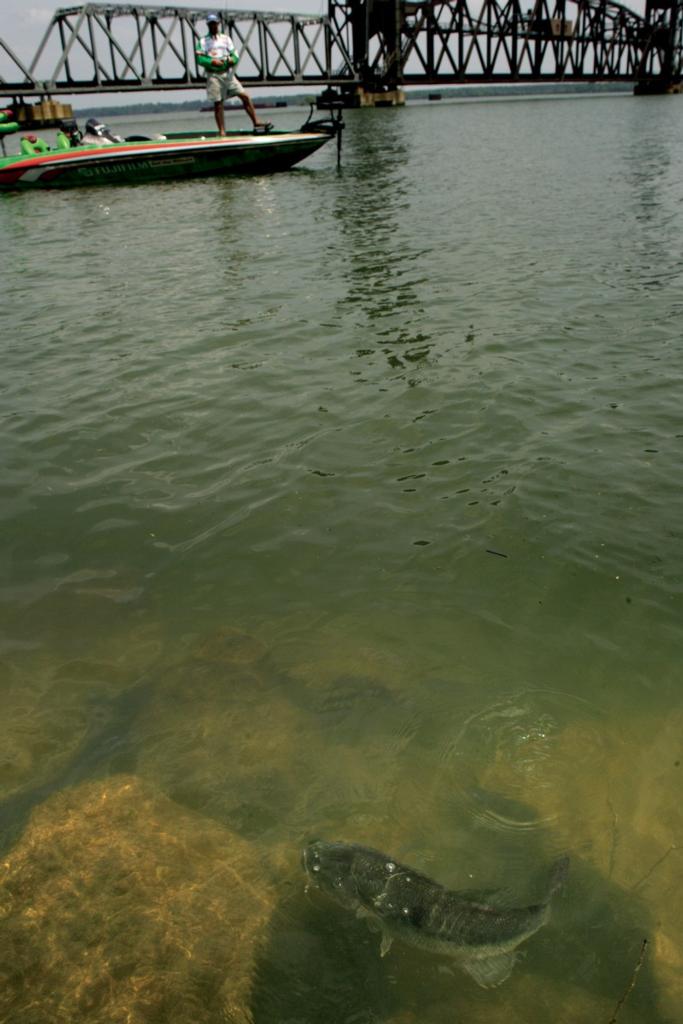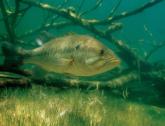Body language
Reading visible bass

If there’s nothing more fulfilling than spotting and catching a shallow bass, nothing can be more frustrating than spending an hour working a fish that refuses to eat your bait. Sight-fishing is one of the most exciting ways to catch bass. It’s also one of the most agonizing when bass seem to ignore every lure you put in front of them.
Actually, catching visible bass has more to do with your ability to read their body language than it does with your skills at choosing and using the right lure. It’s knowing when a fish is most vulnerable by how it acts when you show up and start working it that determines your sight-fishing prowess. Whether bass are soaking up the first warm rays of an early-spring sun, guarding a bed full of eggs or cruising across a shallow, open flat, their body language can tell you whether to spend time working the fish or keep on moving down the bank in search of another.
Body language
Yamaha pro John Crews and Ranger pro Rob Kilby learned how to identify and interpret subtle movements by watching hundreds of fish for countless hours over the course of their careers. They can tell if a fish is catchable by how it reacts to either a lure or an approaching boat, how its fins flutter when something disturbs it and how it behaves when a bream swims by. All offer vital clues.
“The fins can give away a lot about a bass,” Crews said. “The way the tail, the pectoral fins and the dorsal fins move when I either approach a fish or cast a lure near it all tell me something about its mood. I like to see a tail that is waving like a flag in a light breeze when I first spot a bass. If the fish is just sitting there and her tail is waving a little, then that tells me she’s comfortable, which is a good sign.
“When her pectoral fins start going back and forth real fast when my lure is near it, she’s agitated. I get real pumped when I see that because I know she’s about to eat my lure, or she’s at least thinking about it real hard.”
Kilby likes to see a bass make a quick turn toward his boat as he approaches it. That means the fish is defensive, likely guarding a bed or a ball of fry. It also means the fish is probably willing to eat a bait. Crews also likes to see that defensive posturing and says those bass can be the easiest to catch, especially if they don’t leave their beds.
He also watches how a shallow bass reacts to a passing bream, another bass or any other potential threat to a bed full of eggs or a pod of fry. Bass will often ignore bluegills on one side of their beds while they turn to watch when predators approach from another side. Not only does that show Kilby how responsive and defensive that bass is, it shows him where he should drop his lure.
 Once his bait plops down in the water, Crews then studies the bass and how it reacts to the splash. Of course, both pros never drop a lure directly on top of a shallow bass, even if it does show signs of aggressiveness. That’s a sure way to run it out to deep water. They both try to cast beyond the fish, making sure their lure doesn’t pass directly over the bass as it sails through the air.
Once his bait plops down in the water, Crews then studies the bass and how it reacts to the splash. Of course, both pros never drop a lure directly on top of a shallow bass, even if it does show signs of aggressiveness. That’s a sure way to run it out to deep water. They both try to cast beyond the fish, making sure their lure doesn’t pass directly over the bass as it sails through the air.
“If it’s real spooky, I’ll actually cast my lure up onto the bank and pull it into the water if possible,” Crews said.
Kilby will do the same thing; he’ll focus on the fish and how it reacts to the presence of his lure. Both agree that when a bass turns to face a lure, there’s a good chance it will take a stab at it. Kilby likes to see the fish’s dorsal fin stand up, another sign of defensive posturing and aggression, and when a bass tips up to take a closer look at a bait sitting on the bottom, there’s a good chance that fish will eat it. There are no guarantees, of course, and bass that show all the classic signs of vulnerability can reject a lure or simply ignore it. That’s when Kilby steps on the pedal of his electric motor and searches for another bass. He will, however, return and try to work that same fish again.
“I’ve caught a bunch of fish later in the day or even later in a tournament that I couldn’t catch before,” Kilby said. “Sometimes, the water warms up or their mood just changes. You never know, but if that fish shows all the signs of being catchable when I first start working it, I’ll stay with it for a long time, especially if it’s a good bass.”
Catching cruisers
Bass cruising across an open, shallow flat offer an entirely different challenge. Both pros say those can be the hardest bass to catch, unless they are following a pod of fry. Most cruisers, however, are extremely spooky and run for deep water at the mere sight of a boat or a lure smacking the surface.
“I’d say one out of six or eight cruisers are catchable,” Crews said. “The bass that are moving pretty quick seem to have some other mission in mind, or if they are really getting it, they are spooked and you aren’t going to catch them. On the other hand, if they are moving quickly but erratically, they might be chasing a baitfish that you don’t see. The slower ones are the hardest to read. Sometimes, they might be up there hunting, or they might just be moving away from the boat.”
 No matter how fast a cruising bass is moving across a shallow flat, Crews always makes at least one cast. The key, he says, is to put your lure out in front of the fish in the exact spot that the bass will cross. The lure should fall right in front of the fish as it gets to that spot. It’s a matter of pinpoint timing, accurate casting and plenty of luck. Sound tough? It is, but when everything fits together, you’ll catch that cruiser.
No matter how fast a cruising bass is moving across a shallow flat, Crews always makes at least one cast. The key, he says, is to put your lure out in front of the fish in the exact spot that the bass will cross. The lure should fall right in front of the fish as it gets to that spot. It’s a matter of pinpoint timing, accurate casting and plenty of luck. Sound tough? It is, but when everything fits together, you’ll catch that cruiser.
Spooked. Now what?
So what if a fish bolts for deeper water at the mere sight of your boat? You’ve got a challenge ahead of you, but it’s not one that can’t be overcome. A spooked bass may or may not be catchable, and while most anglers keep moving down the bank when they chase a bass out of the shallows, Kilby will sit tight and wait.
“If it goes out to deeper water and just sits there watching me, I’ll give it five minutes or so before I move on. A lot of times, it will start circling back and eventually end up back on the bed,” he says. “Sometimes, a bass will keep going and won’t come back for a long time, but most of the time, it will come back.”
That’s why both he and Crews will check back for shallow bass they may have spooked, often returning several times in a single day or even throughout the course of a tournament. Sooner or later, those fish will be just right.
“One big mistake I see a lot of anglers make is they give up too easily. Even if a fish doesn’t act like it is interested in your bait, it doesn’t mean you can’t catch it,” Kilby said.
He recalled a 4-pounder he worked repeatedly on Beaver Lake a few years ago. No matter what he did, that bass just wouldn’t eat his lure. So he left. But as he eased off down the bank, Kilby picked up a rod armed with a spinnerbait and cast it back over the bed. She nailed it, and he added her to his livewell.
“I thought I read her pretty well,” he said. “It just goes to show you that no matter how much you think you know, every bass is different. They all have their own personalities.”